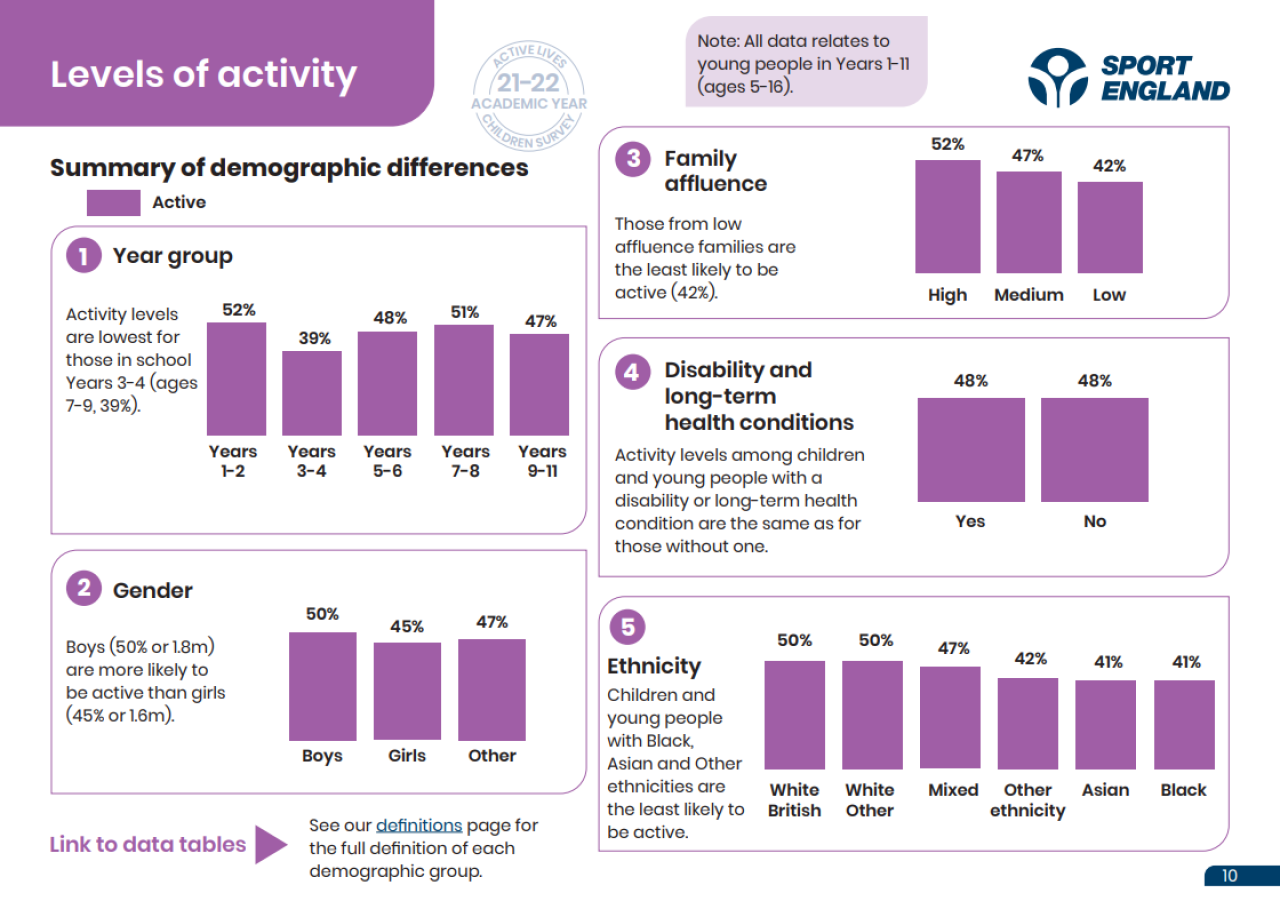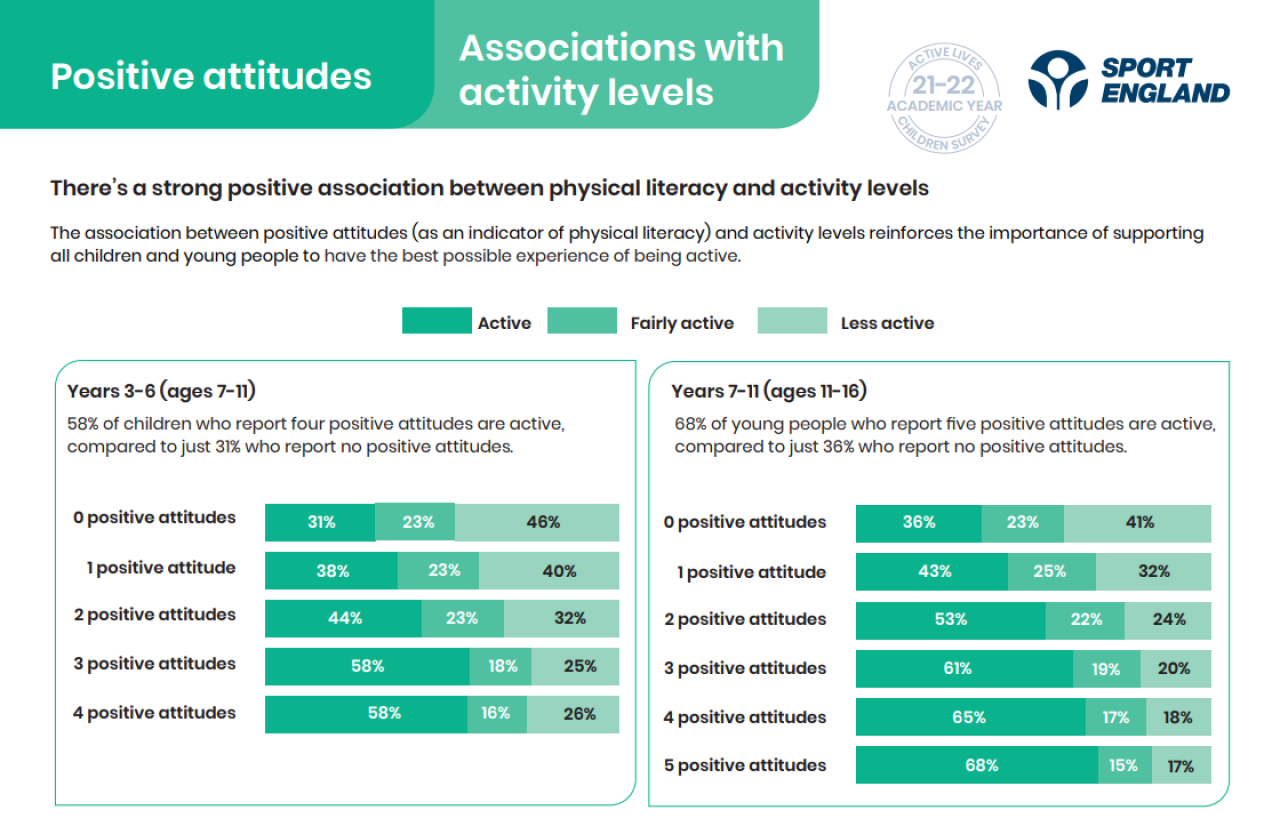The COSMO Study’s initial findings of the impact of COVID-19 on health behaviours feel familiar.
Sport England measures the nation’s engagement with sport and physical activity with our ‘Active Lives’ surveys each year.
While we use different measures to that of the COSMO study, we find similar patterns of inequality in participation, with some groups of children less likely to meet the Chief Medical Officer’s recommended amount of daily activity (an average of 60 minutes a day or more across the week), including: girls; children from less affluent backgrounds and those from Black, Asian and ‘Other’ ethnic backgrounds (shown in Figure 1).
Figure 1: Proportion of young people classed as ‘active’ by demographic characteristics.
(Source: Active Lives Children and Young People Survey, Academic year 2021-22)
We see the same inequalities in how physically literate children feel (as measured by enjoyment, confidence, competence, understanding and knowledge in Active Lives).
A varied picture
Similarly to the COSMO study, during the pandemic we saw activity levels overall decline but some (children from the least affluent families, teen boys and children from Black backgrounds) were more affected than others.
It’s well known that COVID-19 impacted people in different ways.
Research we conducted during the pandemic to understand children’s experience of being active in lockdown found that, for some (particularly teenage girls), the “new normal” was better than “normal”. Some were able to enjoy spending more time with the family, being physically active with them and choosing the additional time they had in the absence of competing behaviours to try new ways to be active on their own terms.
Many children told us they had plenty of space to be active at home and in their neighbourhood and they were loving being outside more.
For others though, it was a very challenging time for them and their families, with parents and carers having less time on their hands to spend time being active as a family.
Older children in particular felt worried about the virus and this put them off being active.
Some children didn’t have enough space at home or near where they live to stay active and didn’t have access to the kind of new kit many children were bought to keep them occupied (e.g. trampolines, bicycles).
Boys tend to rely on team sports to stay active, so were more likely to say they were missing the activities they usually love to take part in and had no interest in trying the alternatives.
This played out in the Active Lives data as we saw activity levels buck the trend amongst teenage girls, with their levels of activity increasing and activity levels amongst boys plummeting.
Changes since lockdown
Since the pandemic, activity levels have broadly recovered, according to the latest Active Lives data.
This is of course good news, with around 219,000 more active children compared to the previous academic year.
Those in school Years 9-11 have seen activity levels increase above pre-pandemic levels (up 5.7%) and we continue to see participation of secondary-aged girls increase over time, helping to close the gender gap.
These positive signs are the result of how hard so many people worked to get sport and activity back safely and enjoyably as restrictions came to an end.
However, the recovery is not universal. Black boys and the children and young people going to school in the most deprived places in the country are more likely to be less active than they were pre-pandemic.
As a result, the gap in activity levels between those going to school in the least and most deprived places has widened.
And it’s not just about numbers of children participating. Children and young people are reporting fewer positive attitudes to sport and activity than pre-pandemic.
The value of being active
This matters because we know the more positive children feel across these areas, the more likely they are to be active: and that the more active and physically literate they are, the more likely they are to be happy, healthy and resilient (Figure 2).
Figure 2: Association between physical literacy and activity levels. (Note: ‘positive attitudes’ are where respondents ‘strongly agree’ to questions related to their enjoyment, understanding and knowledge of physical activity).
(Source: Active Lives Children and Young People Survey, Academic year 2021-22)
There are no ‘silver bullets’ when it comes to tackling the inequalities in sport and physical activity, but results from the places we’ve worked in through our Local Delivery Pilots, where we have been trialling an approach to understand how to use local community identities and structures to deliver sustainable increases in activity levels, show great promise in tackling some of these stubborn inequalities with better results as a collective to similar areas we haven’t worked in.
Activity levels across those 12 areas has now exceeded the levels seen before the pandemic, re-enforcing the value of the highly collaborative, system-based change approach to our work in these areas.
The central premise of our strategy Uniting the Movement is that no-one can deliver change alone. It is only when we join up work and genuinely collaborate to improve the experience of sport and physical activity for children and young people that we can truly deliver that change.
I hope by doing so, we will not only address long-standing inequalities in sport, but use the power of being active to address some of the wider issues highlighted in the COSMO study.
Jessica Forte is Head of Customer Insight at Sport England.
The opinions of guest authors do not necessarily reflect the opinions of COSMO.

